Customer surveys not completed are like bird songs never heard or paintings never seen: so much effort but if no-one responds it’s all for nothing.
There are plenty of simple mistake you can make:
- Don’t send a reminder and the rate drops by 33%.
- Use images for the survey link and the rate drops another 43%.
- Use an unknown “from” in the invite and there goes another 43%.
- Correcting just those three mistakes can lift response rates by 500%.
Increasing your customer satisfaction survey response rate is not difficult but you do need to focus on the detail.
In this post we examine all of those small details so that you can maximise the response rate for your next customer survey.
- How To Calculate Survey Response Rate
- Why a High Survey Response Rate is Important
- Step 1: Have Great Contact Information for Your Customers
- Step 2: Pre-Notify Your Customers
- Step 3: Write a Great Survey Invite
- High Response Rate Invites are Personalised
- The Right From Name
- The Right Subject Line
- The Right Invite Text
- Use Only One Call To Action
- Be Concise and Direct in the Call To Action
- Your Invite must be Mobile Responsive
- Consider Sending The Invite As a Text Email
- Limit Images Unless you Really Know What You Are Doing
- Stay Out of the Spam Folder
- Send a Reminder
- Don’t Ask Too Often
- Use Other Invite Channels
- Step 3: Make your Survey Easy to Complete
- Step 4: Do Something with the Data
- Maximise Survey Response Rate FAQ

How To Calculate Survey Response Rate
Let’s start by confirming how to calculate the response rate for your survey. There are only two variables in the calculation;
Number of Invites
This refers to the individuals you have invited to participate in your survey.
It could include your entire customer base or just a portion of it, depending on your needs.
Number of Completed Surveys or Responses:
This refers to the total number of surveys that have been fully completed and submitted. Keep in mind that partially completed surveys may also be counted if they provide useful information.
Customer Survey Response Rate
The calculation for response rate is simple: it is the number of completed surveys divided by the number of people you invited to respond.
The number is generally reported as a percentage, e.g. a 25% response rate.
In an equation that formula looks like this:

Why a High Survey Response Rate is Important
Improving the survey response rate is valuable in a four ways:
- Reduces statistical error: More responses increases the survey sample size and can reduce the statistical error (standard error, margin of error) in the results that you collect. So you can be more confident in the findings of your survey and in understanding of what your customers think
- Reduces Sample Bias: It can reduce sample bias and in particular non-response bias in your results
- Responders are more loyal: Customers that complete feedback surveys are more engaged with your brand and more loyal, regardless of the score they provide.
- More data is better: not only are the statistical calculations important but you will also collect more qualitative and text data about why your respondents feel the way they do.
Step 1: Have Great Contact Information for Your Customers
The best survey invite in the world is worthless if doesn’t reach the customer because the address (email, SMS, etc) is wrong.
Before you start make sure that you have good contact information for your customers.
B2B email data decays at a rate of about 22% per year.
Surprising as it may seem, even B2B companies with contracts worth hundreds of thousands of dollars per year, often have out of date or incorrect contact information on their key customers.
Because people change employers more often than they did in the past so their contact information changes as well.
B2C data may go bad at a slower rate as people tend to keep these addresses for longer.
Either way every invalid invite address is an increase in non-responses so take some time to clean up your data before you start the survey process.
If you are running a relationship survey in a B2B market you should ask your sales team to review the customer contact data to ensure it is correct just before the invites are sent.
For transactional surveys, ensure staff confirm email address details at the time of the transaction to lift contact rates.
Step 2: Pre-Notify Your Customers
Alerting your customers to expect a survey may make them more disposed to respond and increase response rates.
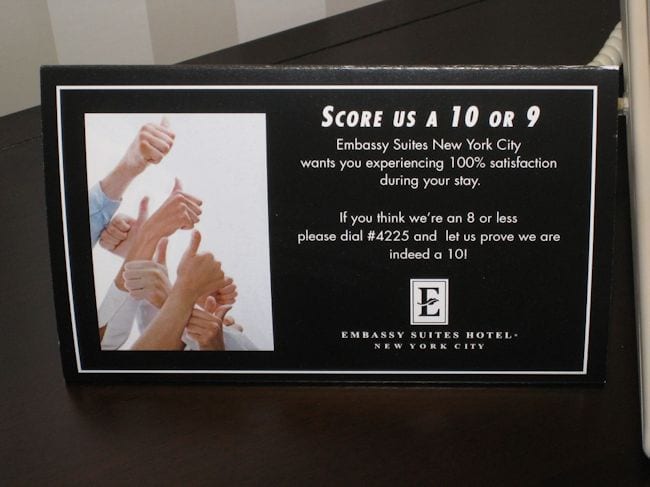
Image Credit: Rob Markey
In B2C situations, coach staff to alert customers to look out for the survey. Make sure, however, that they do not use this as an opportunity for customer survey score begging.
For Business to Business customers, send a pre-notification from someone the customer will recognize, a CEO, country manager, or business leader. Let them know the invitation is coming and what your process is for taking action.
The simple rule of “what’s in it for me” applies so make sure you are clear what is in it for the customer.
Step 3: Write a Great Survey Invite
There can be good reasons to deliver your survey via telephone or face to face but many customer surveys will be web based with an email invite.
In these cases you can use the extensive experience of email marketers to maximise your open and click through rates, which will in help maximise survey completions.
High Response Rate Invites are Personalised
Personalisation is a key strategy for boosting survey response rates and here are some best practices to consider:
Use customer data to tailor invitations
Later we’ll discuss the key elements of the invite – use the data you have on the customer to personalize survey invitations by addressing the customer by name and referencing their recent interactions or purchases. This shows the survey is relevant to them and makes them more likely to participate.
Segment your audience and invites
Divide your customer base into specific groups based on demographics, behaviours, or relationship with your brand. Then, target surveys to each segment with questions that matter most to them. The increased relevancy will increase response rate.
Trigger surveys based on customer actions
Automate feedback requests to deploy based on specific customer milestones or interactions, such as after a purchase, customer service call, or when a product usage goal is met. Timely, contextual surveys tend to get higher engagement.
Follow up personally
After a customer completes a survey, send a personalized thank you message and outline next steps or how their feedback will be used. For high-value customers or concerning responses, consider a personal phone call to dive deeper and strengthen the relationship.
The Right From Name
The subject line and “from” name for your email are very important in driving open and click rates.
43% of email recipients click the spam button based on the “from” name or email address so you need to ensure that it is known to your customer.
Don’t use “Quality Department” or an unfamiliar name. Even if the CEO’s name is familiar to you, it might not be to your client.
In a recent A/B test one of our clients confirmed that simply using a real person’s name as the from address lifted response rates by 50%: [Case Study] Iron Mountain Doubles NPSⓇ Survey Response Rates.
The Right Subject Line
Subject lines are equally important because people also use them for spam identification and deletion.
There are lots best practices we can take from the marketing industry on customer survey invite subject lines that work.
Here are some examples that work well:
- 3 minute survey on your recent purchase
- Tell us what you think – 3 minute survey
- How was our service – 3 minute survey
- How was our service – only 5 questions
- Your recent purchase – 5 questions = 3 minutes
Each of these is unambiguous as to what the email is about and promises a short task.

The Right Invite Text
A great survey invite email should be:
- Simple and to the point.
- Tell the respondent why are they receiving the invite: “You are receiving this invite because you recently shopped at our site.”
- Provide a purpose for the survey: “So we can provide you an even better experience we are collecting feedback on how we performed in our last engagement.”
- Give a realistic estimate of the time it will take, don’t fudge this.
- Give the respondent a place to ask questions if they want to know more about the invite or survey
- Thank the customer in advance for their response.
- Show the survey link, see more below on this.
- Comply with local email sending legislation, i.e. provide unsubscribe options, etc
One way to dramatically lift response rates (+50%) is to embed the first survey question directly in the invite itself:
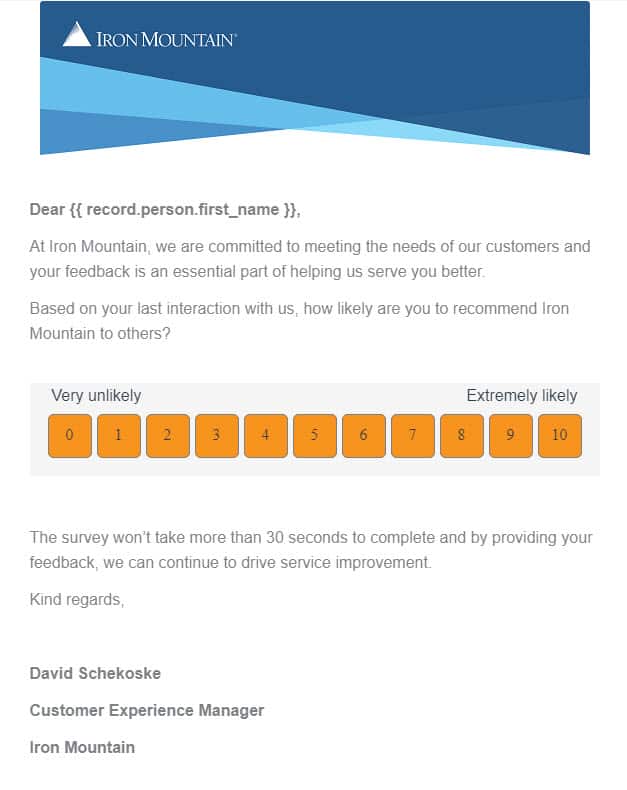
For detailed information on each of these points see: Writing the Perfect Customer Feedback Survey Invitation
Use Only One Call To Action
In your now simply email, make sure there is only one call to action: the survey link.
I know Marketing want you to put in a link to the Twitter and Pinterest accounts and the webinar they’ve been promoting, but resist at all costs.
The more calls to action (links) in the email, the more cluttered it is and the less likely the respondent is to click on the one link you really care about: the survey link.
Be Concise and Direct in the Call To Action
Speaking of that Call to Action: make it clear, action oriented and specify the impact for the customer:
Provide my feedback in 3 questions or less
The use of the first person “my” in this context is important as it has a higher click through rate than the third person “your”.
If you must use an image link then make sure that you also include a simple text version as well to cover for when images are turned off, see below.
Your Invite must be Mobile Responsive
In today’s mobile-first world, optimizing your survey invitations and the survey itself for mobile devices is non-negotiable if you want to maximize response rates.
Your email invitations must be designed to render flawlessly across all devices and screen sizes.
This means using a responsive template that automatically adjusts layout, font sizes, button sizes, and line spacing for easy reading and clicking on smaller mobile screens.
Avoid tiny fonts, cluttered content, large images that push the call-to-action below the fold, or links/buttons that are difficult to click with a thumb.
If you use an HTML email template, be extra diligent in testing how it displays across a variety of mobile devices and email clients. Use email preview tools like Litmus or Email on Acid to ensure compatibility and resolve any rendering issues before sending.
Consider Sending The Invite As a Text Email
You can certainly use fancy HTML email templates but you might also consider a text based email. Testing has revealed that text based emails have higher click through rates (almost double) than HTML templates.
Plus, text based emails are easier to build and can be relied upon to render properly on a mobile device, so they win all round.
You might like to keep the HTML formatting codes so you can create nice looking survey links but make it look like a text email.
Limit Images Unless you Really Know What You Are Doing
If you must send your survey invite as an HTML document, limit image use.
More research indicates that 43% of email clients block images. So if you use images for key parts of your message it will depress response rates.
Here for example is what happens if you get it wrong.
In this Club Med invite (yes big companies get it wrong too) they used images for all of the most important parts of the invite including the key call to action, aka, the survey link.
Even if I really want to respond, from what I see below there is no way to get started on the survey.
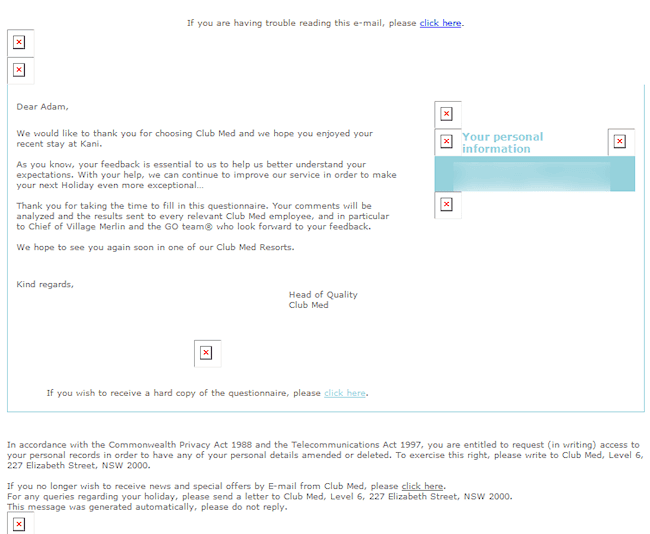
With images download turned on the message looks great but for many a quick “delete finger” that will be too late.
And, even then the all important survey link is almost lost at the bottom. How about at least making it in a contrasting colour – maybe ClubMed blue?
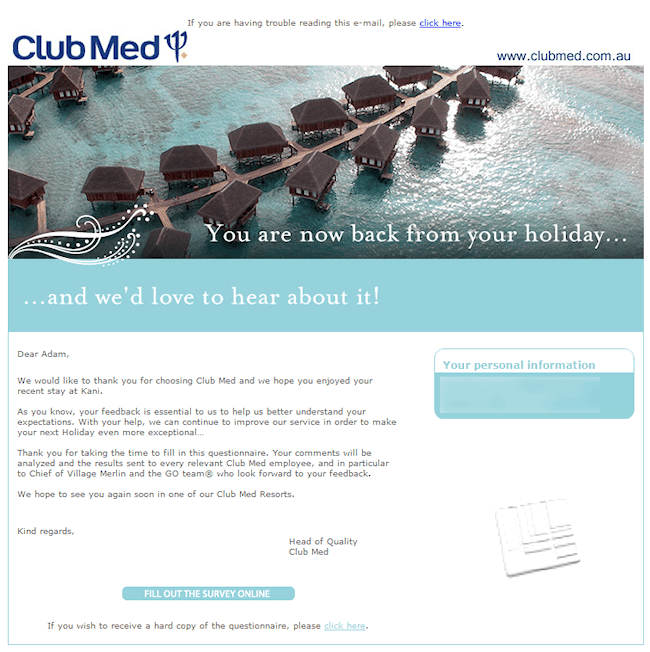
Stay Out of the Spam Folder
If your carefully crafted invite ends up in the spam folder the chance of getting a response to your customer satisfaction survey is, shall we say, limited.
Unfortunately there are no easy rules to ensure your important invite is not tagged as spam. The spam filtering services are very cagey on telling us exactly what not to do so they don’t give the game away to the spammers.
Research does indicate that previous recommendations on what puts you into the spam folder are no longer as important. For instance, putting “free” in your subject line will not automatically get your invite put into the spam folder.
Some actions you can take to reduce the chance of ending up in spam jail include:
- Using a known email address or domain that the customer may already have whitelisted.
- Generally if you have a relationship with them on email it will also mean that you have a better chance to be whitelisted.
- Simple emails with lower image rates also seem to get through more often; even more reason to use the text invite noted above.
Send a Reminder
It’s simple but effective.
In our experience a simple reminder sent to people who have not responded after a few days, results in an average 50% lift in survey completions. So if your rate is 10%, a reminder will lift it to 15%.
Note that you should not use the word “reminder” in the subject line as that will decrease the open rate of your email.
Instead use something simple like:
We really want your opinion
Another chance to provide your feedback
Don’t Ask Too Often
Getting feedback from your customers is good, so getting more must be better. Right? Maybe.
Make sure that you don’t over ask your customers for feedback as your completion rates will drop off quickly.
In the past we used GoToMeeting for our webinars.
After every, yes, every, session they asked for feedback on the service. The first few times I provided feedback but then stopped and have not done their survey for a long time.
Contrast that with the Skype approach where they seem to have a random process and I am asked only every so often. It works as I continue to convert and provide feedback for them on a regular basis.
The big question is how often is too often and unfortunately there is no one rule.
If a customer uses your service often (every day) them perhaps you can survey them once a month. On the other hand if they only interact with you once a year then an annual survey is probably the highest frequency that will be appropriate.
This blog post provides some guidance on selecting survey timing: A Fool Proof Recipe for When To Survey Your Customers
Use Other Invite Channels
Email invites are by far the most common invite vector but think outside the box and try other approaches such as:
- Chat – invite your respondents from inside your website live-chat interface
- SMS – for the right audience sending the invite via mobile phone text messaging can be effective
- WhatsApp / Facebook Messenger/etc – if your customer interacts with you via these channels maybe you should use them for survey invites as well.
Step 3: Make your Survey Easy to Complete
Now that you have the survey invite in your customer’s inbox and they have clicked through — make sure they complete it.
Adequately Pilot Test Your Survey
Before launching your survey to your entire customer base, it’s essential to conduct a pilot test with a small subset of your target audience. A pilot test allows you to gather feedback on the survey experience and identify any potential issues or areas for improvement.
Here’s why pilot testing is crucial:
Uncover technical glitches: A pilot test can reveal technical problems such as broken links, compatibility issues across devices/browsers, or errors in survey logic that could frustrate respondents and skew results.
Ensure clarity: Feedback from pilot testers can help you gauge whether the survey instructions, questions, and response options are clear and easily understood. You may uncover confusing jargon, awkward phrasing, or missing response options that need revision.
Assess survey length: Pilot testers can provide a realistic estimate of how long the survey takes to complete. If it’s taking too long, you can identify which questions to cut to reduce abandonment rates.
Evaluate data quality: By analysing the pilot test responses, you can determine whether you’re receiving the type and quality of data needed to meet your research objectives. You may need to rephrase questions or add more detail to elicit richer insights.
Gather general feedback: Don’t forget to ask pilot testers for their overall impressions of the survey experience. Did they feel motivated to complete it? Were there any confusing or frustrating points? Their input can help you refine the survey to be more engaging and user-friendly.
When selecting pilot testers, aim for a representative sample of your target audience – including those on mobile devices if applicable. The number of testers you need may vary, but aim for at least 10-20 to gather enough feedback. Consider offering an incentive for their time and valuable insights.
Mobile-First Survey Design
Once a user clicks through to your survey from their mobile device, it’s crucial that they can easily read and respond to it on their small touchscreen.
Survey design best practices include:
- A responsive layout that requires no horizontal scrolling or zooming
- Short, concise questions that don’t require extensive reading
- Larger font sizes (at least 14px) for readability and to minimize mis-taps
- Adequate line spacing and padding around tap targets like radio buttons and checkboxes
- A progress bar and/or clear labels to orient mobile users as they complete the survey
- Touch-friendly response formats like vertical rating scales, sliders, and expandable menus
- Images, videos or other embedded content are mobile-optimized in size and placement
- Minimal open-ended questions that are tedious to complete on mobile
Be sure to preview and vigorously test your survey on multiple devices to uncover user experience issues.
Make sure that your survey software provider is able to deliver the survey in a mobile enabled format.
This is not a nice to have option but a deal breaker. If they can’t provide a survey that works reliably on mobile devices, change vendors.
Consider Using an Incentive – But Be Careful
I am often asked whether you should use an incentive such as a competition or free movie tickets to encourage customers to complete the survey.
The general answer is no – if you survey is designed well you will not need an incentive to convince customers to respond.
We also have a post on this topic : Here are the Most Effective Customer Feedback Survey Incentives
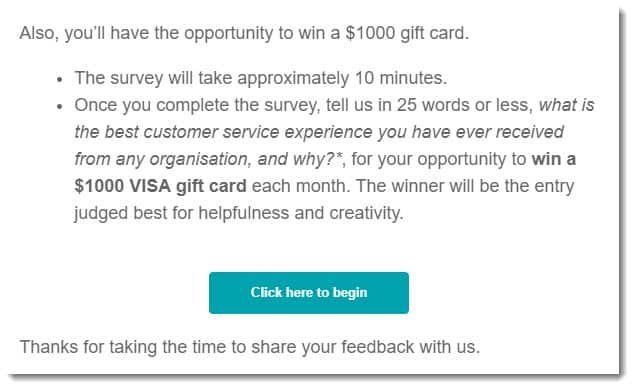
If you do choose to provide a survey incentive use one of the recommendations in that post – not the one shown here: this simply adds a task to my list: “in 25 words or fewer”.
The other reason we generally recommend against an a incentive is the danger that you will just collect bad quality data from the people that just want the incentive.
If the rest of your process is well designed you will not need an incentive.
Keep It Short and Quick to Answer
Good customer feedback surveys are short customer feedback surveys. Every question you add will drive down your response rate.
It is entirely possible to build a very useful and valid customer satisfaction survey with just three questions.
If you find yourself going over 10 questions, stop and review what you’re asking.
The odds are that the survey has transformed into a market research and / or fishing expedition where you sling all manner of questions at the customer hoping to find something useful.
Don’t Ask What You Already Know
Recently a major airline emailed me an invite to their survey. The very first question that that survey was:

Not only is this inconsiderate of your customer’s time, it also adds questions to the survey.
More questions = lower response rates
Try to never ask customers questions to which you already have the answer. Use the survey software to match up the responses with the customer information you already have.
Easy to complete
Your survey needs to be more than just short. It also needs to have the right sort of questions, so it’s easy for customers to complete.
Some question types are easy to answer and some are difficult. Too many difficult questions and your customers will give up.
Here’s an example of an easy question for a customer to answer, and one that can provide good insights to the business.

It’s clear, they have a Not Applicable choice and giving a rating is easy to do – it takes the customer just seconds.
On the other hand open response questions like this are harder for customers to answer because the respondent now has to consider all aspects, then compose and write a comment.
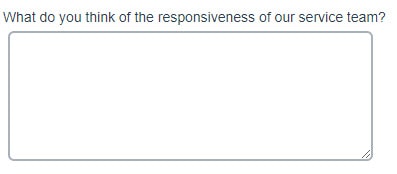
You see, the same topic but very different impact for customers, and for the analysis of your data.
Another common and particularly mentally intense form of question is the prioritize question.
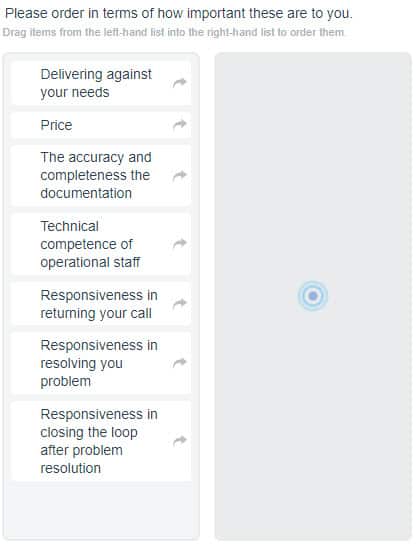
Try to eliminate these questions in your survey as they are not only difficult for customers to answer accurately, they are also difficult to analyse.
Keep it Relevant
Customers will be more comfortable answering questions if they are relevant to their experience with your company and not marketing or sales related.
A professional service customer feedback survey should include service attributes such as trust, attention to detail, reliability, etc. These are attributes that your customers would reasonably expect that you might ask so they are relevant and understandable.
They don’t expect to be asked marketing or sales questions such as:

These questions are not related the service delivery and dramatically cut the trust of respondents, reducing their response rate at the same time.
Ensure the Questions are Easy to Understand
To increase survey response rate ensure that your questions are easy for the respondent to understand.
Ensure that you:
- Use short, single idea questions
- Don’t use jargon
- Don’t use complex sentence construction such as double negatives or multiple parts.

If your questions are complex to understand you also run the risk that respondent will be confused when they answer and do so incorrectly, e.g. answering “yes” when the sentence construction indicates they really mean “no”.
So, it’s crucial to make your questions super clear and easy to understand for the prospects. This is where you can use an online paraphraser to rephrase your questions into simple language without changing the context.

Step 4: Do Something with the Data
You may think that the survey completion rate task is just optimising how the survey is presented to your customer but just as important is the feedback that the customer receives from you.
If you do nothing with the data and customers see no change from the feedback they provide, the survey conversion rate will drop over time.
Customers quite rightly reason that: if you’re not using the information I’m providing why am I bothering?
As an example of how important this is I’ll relate the story of a series of high value business to business customer surveys that I ran for one of our clients.
The respondents were C-suite people giving up 40 minutes of their time for a detailed annual face to face interview. A large investment on their behalf.
One interviewee told me that they were happy to give up their time each year for the interview because they could see our client was actively doing something with the information and their service levels were improving.
Wouldn’t you like to have your customers eager to do your survey?
Also, ensure that you tell the respondent when you act on their input. This doesn’t have to be complex. A simple broadcast newsletter or email telling all customers the changes you have made based on customer feedback will increase engagement with your brand. It will also list response rates in the future.
Maximise Survey Response Rate FAQ
A good survey response rate is one that is above average and that would be anything above 25%.
FluidSurveys published their average response rate for Email Surveys = 24.8% and SurveyGizmo published data showing an average response rate of ~17%. At Genroe our experience, is a response rate of between 10% and 30% depending on how engaged the audience is with the company.
The best way to measure success the is by tracking the response rate of your surveys before and after implementing new strategies. Where possible apply changes one at a time. This will give you a clear indication of which efforts have made a positive impact and allow you to identify areas that may need further improvement.





